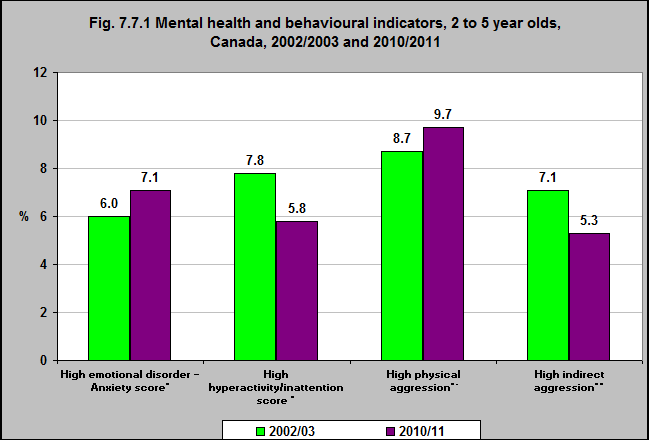Mental health and behavioural indicators, 2 to 5 year olds, Canada, 2002/2003 and 2010/2011

Notes:
*2 to 5 years
**4 to 5 years
Physical aggression was defined as conduct disorder (i.e. violating the basic rights of others, disregarding age‑appropriate social norms) or physical aggression (e.g., kicking or hitting other children).
Indirect aggression is defined as non‑physical behaviour to cause harm to others. It includes behaviours such as gossiping and social exclusion.
High/low behaviour was determined by the 10th/90th percentile cutpoints (as appropriate).
For details on how these scores are developed see The National Longitudinal Survey of Children and Youth (NLSCY) http://www23.statcan.gc.ca/imdb/p2SV.pl?Function=getSurvey&SDDS=4450 -accessed June 22, 2017; and, the Survey of Young Canadians (SYC) http://www23.statcan.gc.ca/imdb/p2SV.pl?Function=getSurvey&SDDS=5179 -accessed June 22, 2017.
Source: CICH graphic created using data adapted from the National Longitudinal Survey of Children and Youth 2002/2003, Statistics Canada – custom runs and Survey of Young Canadians 2010/2011, Statistics Canada – custom runs.
In 2010/11, 7% of 2 to 5 year-olds scored high on the emotional disorder – anxiety score. This was up from 6% in 2002/03.
Approximately 6% scored high on the hyperactivity/inattention scale in 2010/11, down from approximately 8% in 2002/03.
Almost 10% scored high on the physical aggression scale in 2010/11, in comparison with almost 9% in 2002/03.
5.3% of 4 to 5 year-olds scored high on the indirect aggression scale in 2010/11, down from 7% in 2002/03.
